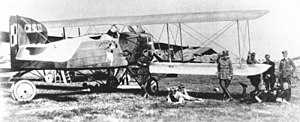
Back هجوم كييف (1920) Arabic Поляк Ғәскәренең Киев операцияһы (1920) Bashkir Operació Kíev Catalan Kiewoffensive (1920) German Ofensiva de Kiev (1920) Spanish تهاجم ۱۹۲۰ کییف Persian Opération Kiev French Serangan Kiev (1920) ID Poloniana operaco Kiyiv IO キエフ攻勢 (1920年) Japanese
| Kiev offensive (1920) | |||||||
|---|---|---|---|---|---|---|---|
| Part of the Polish–Soviet War | |||||||
 Polish Bréguet 14 operating from Kiev airfield | |||||||
| |||||||
| Belligerents | |||||||
|
|
| ||||||
| Commanders and leaders | |||||||
|
|
| ||||||
| Strength | |||||||
|
8 infantry divisions 1 cavalry division 2 understrength Ukrainian divisions. 64,000 men initially.[1] |
8 infantry divisions 2 cavalry divisions later also 1st Cavalry Army. Over 50,000 men initially, including 15,000 battle-ready soldiers.[1] | ||||||
The 1920 Kiev offensive (or Kiev expedition, Polish: wyprawa kijowska) was a major part of the Polish–Soviet War. It was an attempt by the armed forces of the recently established Second Polish Republic led by Józef Piłsudski, in alliance with the Ukrainian People's Republic led by Symon Petliura, to seize the territories of modern-day Ukraine which mostly fell under Soviet control after the October Revolution as the Ukrainian Soviet Socialist Republic.[2]
Polish and Soviet forces fought in 1919 and the Poles advanced in the disputed borderlands. In early 1920, Piłsudski concentrated on preparations for a military invasion of central Ukraine. It would result, he anticipated, in destruction of the Soviet armies and force Soviet acceptance of unilateral Polish conditions.[3][4] The Poles signed an alliance, known as the Treaty of Warsaw, with the forces of the Ukrainian People's Republic. The Kiev offensive was the central component of Piłsudski's plan for a new order in Eastern Europe centered around a Polish-led Intermarium federation. The stated goal of the operation was to create a formally independent Ukraine, although its dependence on Poland was inherent to Piłsudski's plans.[5] Ukrainians ended up fighting on both sides of the conflict.[6]
The campaign was conducted from April to July 1920. The Polish Army faced the forces of the Russian Soviet Federative Socialist Republic.[6] At first, the war was successful for the allied Polish and Ukrainian armies, which captured Kiev (Kyiv) on 7 May 1920, but soon the campaign's progress was dramatically reversed[7] due to a Red Army counter-offensive, in which the 1st Cavalry Army of Semyon Budyonny played a prominent part.[8] In the wake of the Soviet advance, the short-lived Galician Soviet Socialist Republic was created. The Polish-Soviet War ended with the Peace of Riga of 1921,[8] which settled the border between Poland and the Ukrainian Soviet Republic.
- ^ a b Cite error: The named reference
Chwalba 186–189was invoked but never defined (see the help page). - ^ Cite error: The named reference
EB_RPWwas invoked but never defined (see the help page). - ^ Cite error: The named reference
Chwalba 158–166was invoked but never defined (see the help page). - ^ Cite error: The named reference
Chwalba 167–171was invoked but never defined (see the help page). - ^ Cite error: The named reference
Debo210was invoked but never defined (see the help page). - ^ a b Cite error: The named reference
Abbotwas invoked but never defined (see the help page). - ^ Cite error: The named reference
Roshwald_p144was invoked but never defined (see the help page). - ^ a b Cite error: The named reference
Magocsiwas invoked but never defined (see the help page).
© MMXXIII Rich X Search. We shall prevail. All rights reserved. Rich X Search